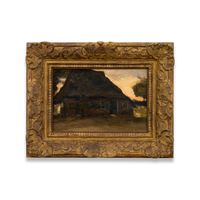Post-impressionist artist Vincent Van Gogh is much admired for his highly individual paintings that use innovative colour and undulating distortion to convey emotional power, and was legendary for his tortured and tempestuous personality. His landscapes, portraits, and still lifes convey a startlingly restless energy and fluidity of form.
Read MoreVan Gogh only painted in the last ten years of his life, creating almost 900 works. The last five years, his French period, were his most significant. His father was a Dutch pastor and Van Gogh was a believer all his life. Van Gogh became an evangelist amongst the poor in Belgium, but before that he worked in a number of jobs. These included Goupil & Cie, an art dealing firm in The Hague, London, and Paris, which also employed his younger brother Theo, to whom he was close.
Dismissed from missionary work in 1880, he returned to his father's house in Etten. He then lived in penury in various cities in the Netherlands, but taught himself to draw and paint, rendering the hardships of peasant life. Works from this Dutch period, dark and sombre in tone and emphasising plasticity, show the influence of Rubens' colour theory, and Van Gogh's fascination with the Japanese prints with which he decorated his studio. Works from this time include The Potato Eaters, Peasant Woman Cooking by a Fireplace, and The Potato Peeler (all 1885). A bad diet and excessive drinking and smoking took its toll.
After attending academies in Brussels and The Hague, in 1886 he attended drawing and painting classes at the Academy of Fine Arts in Antwerp, but fell out with his teachers. He was asked to repeat the year.
Instead, in 1886 he returned to Paris, staying initially with Theo and painting local street scenes and parks. There he met a coterie of painters that included Henri de Toulouse-Lautrec, Edgar Degas, Camille Pissarro, Georges Seurat, and Paul Signac. It was then that Van Gogh also befriended Paul Gauguin, who had just arrived in Paris. By chance Van Gogh discovered a portrait by Adolphe Monticelli, which pushed him into experimenting with brighter colour. In 1887 he organised a much-discussed group exhibition in Montmartre. He swapped paintings with Gauguin, and, exhausted from over-work, fled south to Provence.
In 1888 Van Gogh settled in Arles, where he had a period of intense productivity, much linked to the 'Yellow House' which he used as a studio. His work at this time showed the influence of Japanese prints, tilting the picture plane and introducing swirling rhythms, while his landscape imagery, interiors, and portraits became more convulsive compositionally. His colour became more saturated, and the brushed-on paint more expressive. Works from this period include some of his most renowned, such as Van Gogh's Chair (1888), Sunflowers (1888); The Night Café (1888), Self Portrait (1889), and The Starry Night (1889).
In 1888 he persuaded Paul Gauguin to come and stay so they could paint together and discuss ideas as equals, but their relationship was volatile, with Gauguin domineering and arrogant and Van Gogh experiencing psychotic episodes. Inevitably they fell out. While retaining considerable skills as an finely tuned colourist and observant draughtsperson, Van Gogh at this time was greatly troubled by the mental illness which led to his ear-mutilation and eventual suicide in 1890.
Van Gogh's troubled interiority and use of intense colour and vibrant brush marks were immensely influential on many artists, such as Edvard Munch, and avantgarde groups like the German Expressionists and the Fauves.
Van Gogh has been the subject of both solo exhibition and group exhibitions. Solo exhibitions include Van Gogh: His Life in Art, The Museum of Fine Arts, Houston (2019) and Van Gogh & Japan, Tokyo Metropolitan Art Museum (2017).
Group exhibitions include Work, Pray and Admire: A New View on Art and Calvinism, Dordrechts Museum, Netherlands (2019); Société des Artistes Indépendants, Paris (1890); and Les XX, Brussels (1890).
Van Gogh's work is represented in major collections around the world, most significantly at Van Gogh Museum, Amsterdam; Kröller-Müller Museum, Otterlo, Netherlands; and Musée d'Orsay, Paris.
John Hurrell | Ocula | 2021




